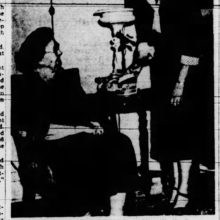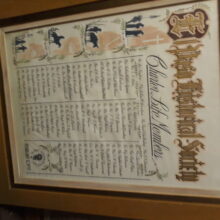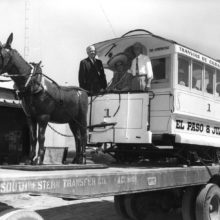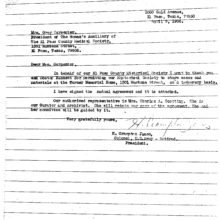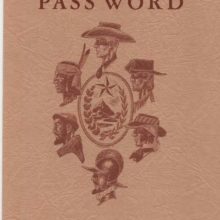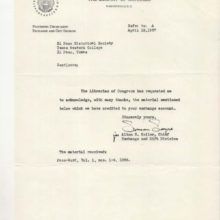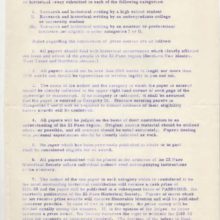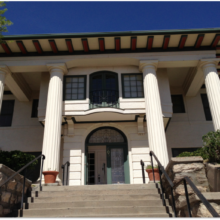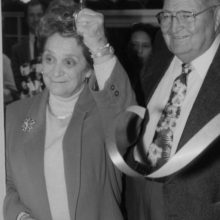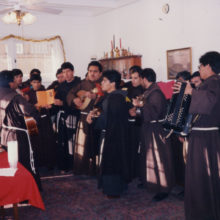Preserving Local History: El Paso County Historical Society 1953-1986.
Since 1954 the El Paso County Historical Society has been the driving force of the historic scene of El Paso. EPCHS strives to foster research into the history of the El Paso area; share that history with the public; publish and encourage historical writing pertaining to the area, and develop public consciousness of our rich heritage.
We strive to fulfill our mission in the following: by hosting and partnering with other organizations for events; maintaining our headquarters, the Burges House, built-in 1912; and maintaining an extensive collection of Southwest archives in the Jane Burges-Perrenot Research Center, including over 20,000 photos, thousands of historical documents, and scores of three-dimensional items.
Joseph Longo, EPCHS Curator
- The Pioneer Association of El Paso was formed in 1904 by men who had come to the city before 1900. Among its ranks were builders, merchants, traders, lawyers, farmers, miners, and others who came west to make a new life or find their fortune. You can consider it the first historical society in El Paso. They collected historical artifacts and stories from El Paso Pioneers. Most of the association’s archives, which contained many historic items and documents were donated to the Society in 1980.
- Black Ribbon, a memento of the Pioneer Association.
- In 1928, the Pioneer Association organized an auxiliary to the organization called the El Paso historical society. This society did not last long.
- The El Paso County Historical Society was organized on March 18,1954 the original name was the El Paso Historical Society,but it was later renamed in 1961.
- In September of 1953, at the urging of Cleofas Calleros, the Women’s Department of the Chamber of Commerce undertook the project of creating an El Paso Historical Society.
- The initial organization of the society was undertaken by the Women’s Chamber of Commerce Subcommittee, Civic Improvement led by Mrs. Louise Schuessler. The committee also included Gretchen Gabriel (Rabb), Monica Hunter, Mrs. Andy Fuentes, Dollie Lanier, and others.
- The El Paso Women’s Chamber of Commerce Ladies recruited members and planned the organizational meeting.
- March 1954. Committee on writing constitution and by-laws of EPCHS initiated by Mrs. Schuessler. Left to right Mrs. R.E. Sherman, Mr. Allen Sayles, Mrs. W.W. Schuessler, Mr. Frank Hunter. Victory Room basement of old C of C Building.
- Louise Schuessler presided over the first meeting on March 18,1954
- On March 18, 1954, the El Paso Herald-Post reported at the first meeting there were forty-two charter members then it increased to seventy-eight. On April 27, there were 273 members.
- Ira Turney, the first paid life member. She wrote a check for one-hundred dollars.
- El Paso’s artist, Kate Krause Ball painted two large scrolls and a smaller one for the society. Theses scrolls have a list of the first charter and life members of the society. They are still safely stored in our archives.
- Charter Life Member Scroll.
- Ball’s bill for her work on the scrolls.
- Kate Krause Ball was a pioneering and prominent artist who was inspired by the southwest and also ancient biblical and Asian calligraphy. Photo Credit: El Paso Historical Society.
- When the society was first organized Louise Schuessler wrote an award-winning article about the Society that was published in History News.
- A page from a draft of Schuessler’s History News, Louise Schuessler’s article.
- On July 26, 1954, Mrs. Schuessler turned over the gravel to Paul Heisig, who was elected president. She, Calleros, and Dottie Lanier was elected vice presidents.
- The first board of the El Paso County Historical Society.
- Paul Heisig, President of Elite Laundry Co., was elected the first President of EPCHS. As president,he led efforts to preserve the Old Mule Car.
- Early board and committee members of the society.
- Heisig and Chris Fox led successful efforts to preserve, restore the mule car, and display it to the public.
- Chris P. Fox was called “ Mr El Paso” for his active involvement in the El Paso Community. He served as President of the El Paso National Bank and of the Chamber of Commerce. He also served as El Paso County Sheriff.
- The Mule Car was restored. The stature of Mandy was donated by Odd Fellows Lodge 284. The stature of the driver named Pedro was also furnished. The Car stood in San Jacinto Park, currently, it is on display at Sun Meto HQ in Downtown El Paso.
- A Resolution was passed by the society to commend the SP Railroad for their gift to the city.
- In May of 1956, the Society convinced Southern Pacific Railroad to donate the stream locomotive engine no. 3420. The unveiling of the engine took place at a ceremony celebrating the 75th anniversary. The Engine was on display at the Union Depot. Currently, it is stored at the Phelps-Dodge Plant.
- The El Paso County Historical Society also helped the city acquire another historic locomotive called engine No.1.
- One of the early projects of the society also included laying markers and plagues at different historical landmarks in El Paso county including the missions. Thanks to Dr. Joseph Leach, a plaque was placed at Hueco Tanks. The Committee was led by Betty Brunner in the early days.
- The Society successfully fought for the Historic designation of San Elizario under the leadership of President, Richard C. White. May 5, 1962, El Paso Times.
- The Society continues our preservation efforts. In 2017, as a board, we advocated for the preservation of the First Ward one of the oldest neighborhoods in El Paso.
- The Society is working to preserve the Rudolph Von Ripper Mural at Fort Bliss.
- From the beginning of the organization, the society received donations of historical artifacts relating to our region.
- The first curator was El Paso Library Director, Helen Farrington.
- Betty Goetting and Cleofas Calleros were appointed to the Historic Relics Committee.
- Betty Goeting was appointed curator in 1956 serving for 25 years.
- 1966-1967 curator report by Betty Goeting.
- Fred Bailey succeeded Goetting as curator in 1974. When the El Paso Medical Society allowed EPCHS to use a locked room for storage they were able to take a good inventory of the society’s archival holdings for the first time. He had previously served as EPCHS President.
- Letter thanking the El Paso County Medical Society for use of a room for storage of historical artifacts.
- Joseph B. Leach had a thirty-eight-year teaching career in the English Department at UTEP after a career in the Military. During his term as EPCHS president, many acquisitions were received such as old rainspouts from the Amador historical home in Las Cruces. Other early donations included an 1826 document signed by members of the Coons Family, and the Spanish survey of the Land and Water Rights of the City of Concepcion, Chihuahua dated 1639.
- In 1971, the Harry Mitchell Collection was donated to EPCHS.
- William I. “Bill” Latham, El Paso Times editor and published author. He also served as curator at EPCHS.
- Bill Latham created the current system the society uses to organize our archive. It was named after him.
- The Society displayed and stored their artifacts all over the city including at Radford School until we found a permanent home at the Burges House in 1986. By 1990 all our archives were housed at the Burges House.
- In 1974, Some of the EPCHS Archives were being stored at the Plaza Theater, because the Society became part of the movement to save it.
- In 1977, under the leadership of EPCHS president James Peak and Bill Latham, the Society became a sponsoring organization of the El Paso Calvary Museum which later became the El Paso History of Museum in 1980. It helped establish the museum. The Society was allowed to store some of their holdings in a room in the museum which was first located in far east El Paso. This arrangement ended in the 1990s.
- Barbara Reese succeeded Bill Latham as a curator in 1996. With a group of dedicated volunteers, she led efforts to digitize archival documents and put the society’s inventory in electronic format. Frank Gorman donated the first computer in the late 1990s.
- Password was first published in 1956 with Eugene Porter as editor. The logo was designed by renowned artist, Jose Cisneros, with help from Tom Lea. They were joined by renowned printer, Carl Hertzog. EPCHS President Joe Leach is credited for coming up with the title, Password. He came up with the Password saying he saw it as the “Word of the Pass”. The title was first hyphenated then it became one word like it appears today.
- An early draft of the cover of the Password. At one point the editor had hopes UTEP artist, Vera Wise would design the password. The first membership dues gathered was to go to the publication of a historical quarterly.
- A letter between Frank Fuellie EPCHS President and Eugene Porter in which they discussed the planning of the first issue of Password.
- Phyllis Maniz was the book review editor and was on the first editorial team for the Password.
- Different institutions, like the Library of Congress, purchased a subscription to the Password. The Password was also recognized nationally.
- The Library of Congress became interested in carrying the Password when it was first published.
- The annual prize awards for essays and articles were started in the late 1950s under EPCHS President, Jack Vowell.
- EPCHS continues this tradition by sponsoring the Gorman Family award for the best individual essay contest at UTEP History Day.
- Harriet Howze Jones edited and compiled “El Paso: A Centennial Portrait,” published by the Society. She was the wife of EPCHS President, H. Crampton Jones.
- Each year as part of our Hall of Honor we select living and deceased El Paoans who are considered to be outstanding men or women of character, vision, courage, and creative spirit.
- Richard Crawford White, U.S. Congressman. and EPCHS president planned our first Hall of Honor Awards. Dr. Lawrence Lawson and James Wiley Magoffin were the first inductees in 1961.
- James Wiley Magoffin, settled Magoffinville, one of the early settlements that made the modern city of El Paso.
- Lawrence M. Lawson Commissioner International Boundary Water-Commission U.S. Mexico1927-1954.
- Tour of Homes was a concept developed by the Society under President James Peak in 1977, before that it hosted other kinds of tours of historic places in El Paso. The Tradition is continued by our participation in the annual Sunset Heights Tour of Homes.
- Richard Burges’s daughter, Jane Rust Burges Perrenot, donated the Burges House to the El Paso Historical Society upon her death in 1986. She served as President of the Board of the City Library. She also served as President of El Paso Junior League and helped established the Southwestern Collection at the El Paso Main Library. She also chaired the El Paso City Library Board of Directors.
- The Burges House in the Sunset Heights Historic District was built for Richard Fenner Burges by contractor J. E. Morgan. Alterations and additions were made in 1927 under the direction of architect Otto H. Thorman. Facing west, the two-story house carries the Adams Architectural style from the Georgian Revival manner popular in El Paso from 1881 to 1940. The Burges House is an El Paso Historic Landmark, on the National Register of Historic Places, and was designated as a Recorded Texas Historic Landmark in 1993.
- Our Burges Garden rests on what used to be Mesa Gardens, a once-famous early resort area.
- Richard F. Burges.
- This Chair was used by Richard Burges when he was serving in the Texas State House of Representatives.
- This tea dress belonged to Richard Burges’ wife, Ethel Shelton. The dress was donated by her great-great-granddaughter, Jane in 2008.
- Bill Hooten accepting the Hall of Honor for his grandmother, Jane Rust Burges in 2005.
- Mary Perranot Frasier, daughter of Jane Burges Perranot at the opening of the Jane Burges Perranot Research Center named by Bill Latham.
- Richard Burges’s granddaughter, Barbara Clawson located an old journal of his and along with the society published excerpts for benefit of the El Paso Historical Society.
- 2000 Christmas Open House at the Burges House. The tradition was started by Jane Burges Perranot her motto was “Once invited always invited.” In 1987 the Burges House Commission was created to care for the Burges House. In 1992 they brought the tradition back and we have continued it ever since.











